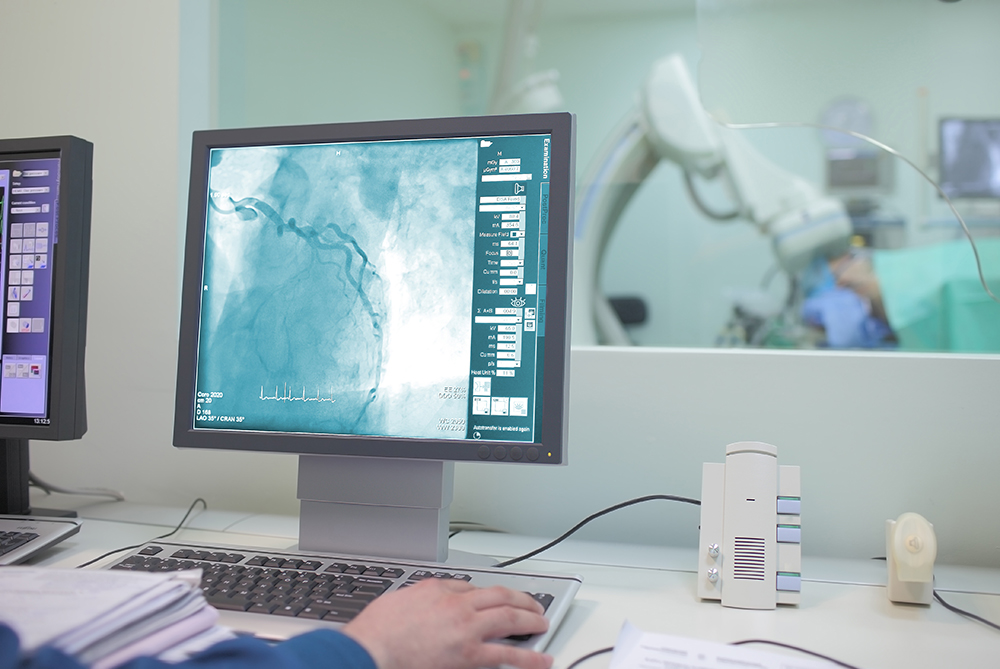What is a CTCA?
This is a test that allows us to see the heart arteries in more detail. It involves lying in a CT scanner, and having a special dye injected into a vein in the arm through a cannula. The dye reaches the heart and the CT machine produces X-rays that pass through the body, which the dye then reflects. This allows us to tell if there is any significant furring-up (atheroma) in the heart arteries. The computer then reconstructs the heart arteries into a 3-Dimensional picture that we analyse.
How is a CTCA done?
The technologist will clean three small areas of your chest and place electrodes (small, sticky discs) on these areas. Men may require a small area of hair to be shaved on their chest to help the electrodes stick. The electrodes are attached to an electrocardiograph (ECG) monitor, which shows your heart’s electrical activity during the test.
A nurse or technologist will insert an intravenous (IV) line into a vein in your arm to administer contrast material during your procedure. While in the CT scanner, you may be given a beta blocker medication through the same IV line or by mouth to help slow your heart rate in order to improve image quality. Nitroglycerin (or GTN-glycerine trinitrate) may also be administered to dilate and improve visualization of the coronary arteries, as a tablet, a spray underneath your tongue or a patch on your skin.
While lying on the scanning table, you may be asked to raise your arms over your head for the duration of the exam. This will help improve image quality.
Next, the table will move quickly through the scanner to determine the correct starting position for the scans. Then, the table will move slowly through the machine for the actual CT scan. Depending on the type of CT scan, the machine may make several passes.
The technologist may ask you to hold your breath during the scanning. Any motion, including breathing and body movements, can lead to blurring of the images.
Please let me know if you have problems holding your breath for 5 to 15 seconds. Breathing during the scan creates blurring on the images and can result in an inconclusive exam.

Why has a CTCA been requested for me?
This scan allows us to look at the heart arteries and tell if there are any significant abnormalities. Typically this scan will be requested if a person if having chest pain and the cause is unclear. The scan results will help to decide if the pain is as a result of an abnormality of the heart arteries, or not. Sometimes the scan is requested if the heart function is abnormal on a previous scan (such as an echocardiogram) to determine if the abnormal function is due to furred-up or blocked heart arteries, even if the person has no chest pain. Sometimes other symptoms such as shortness of breath are evaluated further with this scan, if other tests are found to be normal.
What are the advantages of a CT scan over other tests to look at the heart?
A CT scan of the heart is relatively quick procedure (it takes about 10 minutes to do). It is relatively non-invasive as only a cannula is required. It provides a lot of information and very clear pictures of the heart, and can rule in, or rule out, a cause for your symptoms. More recently a technology has been developed to measure blood flow down the arteries of the heart (CT-FFR). Results of CT-FFR are usually looked at in combination with other tests in order to provide the appropriate treatment. Depending on the results I may recommend having a test called a coronary angiogram and pressure wire study to obtain the most accurate measurements of the coronary anatomy and blood flow, as a coronary angiogram is regarded as the “gold standard” test for this purpose.
What are the disadvantages of a CTCA?
This scan uses X-ray radiation, and although the dose of radiation is small, I will still consider other tests if we should avoid radiation, for example in women who are breast feeding. The dye contains iodine and therefore if you have a severe allergy to this substance I may seek an alternative test which does not use this dye. A slow, regular heart rate is required to provide the clearest images. Therefore if your heart rate is a little too fast we may give you a drug called a beta blocker to help slow it down. If your heart rate is irregular, for example if you have atrial fibrillation (AF), the scan may not provide accurate pictures and I may require an alternative test to be done such as a coronary angiogram. If you have difficulty holding your breath then a CTCA may not produce clear images, as the movement of the heart during breathing can lead to the images being blurred.
